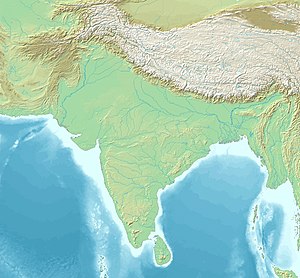Minor Pillar Edicts
| Minor Pillar Edicts of Ashoka | |
|---|---|
 Minor Pillar Edict on the Sarnath pillar. | |
| Material | Sandstone |
| Created | 3rd century BCE |
| Present location | India, Afghanistan |
| Part of a series on the |
| Edicts of Ashoka |
|---|
The Minor Pillar Edicts of Indian Emperor Ashoka refer to 5 separate minor Edicts of Ashoka inscribed on columns, the Pillars of Ashoka, which are among the earliest dated inscriptions of any Indian monarch. A full English translation of the Edicts was published by Romilla Thapar.[1]
These edicts are preceded chronologically by the Minor Rock Edicts and may have been made in parallel with the Major Rock Edicts. The inscription technique is generally poor compared for example to the later Major Pillar Edicts, however they are often associated with some of the artistically most sophisticated pillar capitals of Ashoka. This fact led some authors to think that the most sophisticated capitals were actually the earliest in the sequence of Ashokan pillars and that style degraded over a short period of time.[2]
These were made probably made at the beginning of the reign of Ashoka (reigned 262-233 BCE), from the year 12 of his reign, that is, from 250 BCE.[3]
History[]
Ashoka was the third monarch of the Maurya Empire in India, reigning from around 269 BCE.[4] Ashoka famously converted to Buddhism and renounced violence soon after being victorious in a gruesome Kalinga War, yet filled with deep remorse for the bloodshed of the war. Although he was a major historical figure, little definitive information was known as there were few records of his reign until the 19th century when a large number of his edicts, inscribed on rocks and pillars, were found in India, Nepal, Pakistan and Afghanistan. These many edicts were concerned with practical instructions in running a kingdom such as the design of irrigation systems and descriptions of Ashoka's beliefs in peaceful moral behavior. They contain little personal detail about his life.[4]
List of the Minor Pillar Edicts[]
Asoka’s Minor Pillar Edicts are exclusively inscribed on several of the Pillars of Ashoka, at Sarnath, Sanchi, Allahabad (a pillar initially located in Kosambi), Rummindei and Nigali Sagar. They are all in the Prakrit language and the Brahmi script.
These pillar edicts are:[1]
- The Schism Edicts
Asoka’s injunction against shism in the Samgha. Found on the Sarnath, Sanchi and Allahabad pillars. These are among the earliest inscriptions of Ashoka, at a time when inscription techniques in India where not yet mature.[5] In contrast, the lion capitals crowning these edicts (Sarnath and Sanchi) are the most refined of those produced during the time of Ashoka.[5]
All the Schism edits are rather fragmentary, but the similarity of their messages permit a clear reconstruction:
"The Beloved of the Gods orders the officers of Kauśāmbī/ Pāṭa(liputra) thus: No one is to cause dissention in the Order. The Order of monks and nuns has been united, and this unity should last for as long as my sons and great grandsons, and the moon and the sun. Whoever creates a schism in the Order, whether monk or nun, is to be dressed in white garments, and to be put in a place not inhabited by monks or nuns. For it is my wish that the Order should remain united and endure for long. This is to be made known to the Order of monks and the Order of nuns."[6]

Kosambi-Allahabad Schism Edict.

Sanchi Schism Edict.

Sarnath Schism Edit.
- The Queen's Edict

Ashoka announces that the Queen should be credited for her gifts. Found on the Allahabad pillar.
"On the order of the Beloved of the Gods, the officers everywhere are to be instructed that whatever may be the gift of the second queen, whether a mango-grove, a monastery, an institution for dispensing charity or any other donation, it is to be counted to the credit of that queen … the second queen, the mother of Tīvala, Kāruvākī.[7]
Commemorative inscriptions[]
Although generally catalogued among the "Minor Pillar Edicts", the two inscriptions found in Lumbini and at Nigali Sagar are in the past tense and in the ordinary third person (not the royal third person), suggesting that are not pronouncements of Ashoka himself, but rather later commemorations of his visits in the area.[8] Being commemorative, these two inscriptions may have been written significantly later than the other Ashokan inscriptions.[8]
- The Lumbini pillar inscription
Records the visit of Ashoka to Lumbini, location of the birth of the Buddha, in today's Nepal.
| Translation (English) |
Transliteration (original Brahmi script) |
Inscription (Prakrit in the Brahmi script) |
|---|---|---|
|
|





